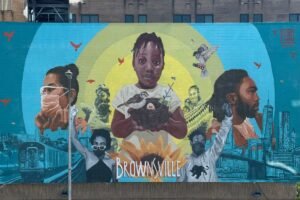
This is the fourth article in NPQ’s series, Just Transition: Liberating Finance to Build a Better World. Coproduced with Justice Funders, a group that organizes philanthropy to advance a just transition to an equitable and sustainable economy and planet, this series highlights case studies of emerging funding networks that are facilitating investment in liberatory economic practices in frontline BIPOC communities.
Thriving communities that value homes as places that reinforce connections and intergenerational relationships among neighbors are what families across the United States are fighting for. The inaccessibility of the housing market calls on us to reimagine our relationship with land and housing from a means to build generational wealth as a waterway for creating strong, stable neighborhoods.
Making this shift requires removing land and housing from the speculative market by investing nonextractive capital into community-stewarded housing projects. Black, Indigenous, and people of color (BIPOC) communities continue to be heavily exploited by private investment firms looking to prioritize profit margins at the cost of ongoing tenant displacement. Fortunately, groups like Right to the City, where I work, are developing strategies that build grassroots power to halt gentrification and displacement and build more democratic, just, and sustainable communities.
My Personal Story
In the fourth quarter of 2023, investor groups bought 18.5 percent of all homes and 26.1 percent of low-cost homes.
Like many across the country, my family was heavily impacted by the 2008 market crash. After struggling for over 15 years to buy their first home, my parents were able to close on a loan in December 2006.
But amid the Great Recession, for my family, the American dream quickly turned into a nightmare. I remember being in college and getting a call from my parents when the sheriffs came by our front doorstep to let my family know they needed to vacate our home of five years. The bank foreclosed on our house due to my family’s inability to pay and forced us out in 72 hours. I met my family later that night to help them offload the U-Haul with our belongings into an apartment complex my dad had secured at the last minute when he realized there was no hope of saving our home from the bank. That night, I slept on the floor with complete clarity that our system had failed us.
My family’s experience was not unique. Nearly 10 million Americans lost their homes to foreclosure between 2006 and 2014—and these were disproportionately people of color. When my parents bought their home, homeownership seemed reachable. Many families were taking advantage of so-called “accessible loan products.” The reality, however, is that these loan products were subprime loans with short-term balloon payments. Many found themselves underwater with mortgages two to three years after buying their homes. The aftermath was a massive step back in generational wealth BIPOC communities had slowly built over the previous couple of decades.
Contextualizing the Problem
These days, many BIPOC families have still not recovered from the setbacks of the Great Recession. Many buyers of starter homes in today’s economy are not young people; they are large investment groups. In the fourth quarter of 2023, investor groups bought 18.5 percent of all homes and 26.1 percent of low-cost homes.
We must undo the notion that speculation around a person’s home is a fair and sound way to conduct business. It is not.
A fundamental problem with our current housing system is treating land and housing as a profitable commodity rather than a collective resource our communities need to sustain and thrive. A home is seen as an investment to be flipped for profit instead of a place to settle and find stability.
Venture capital and large real estate groups see underresourced communities across cities and rural areas of the country as prime real estate for profit. The deals that will yield the highest profits can be found in historically underresourced communities because cash-rich investors can scoop up homes at bargain prices, make minimal repairs, and later sell at exorbitant amounts. One example is Jamison Services in the neighborhood of Koreatown in Los Angeles. Following the civil unrest of 1992 in Los Angeles, Jamison Services founder Dr. David Y. Lee purchased many properties and held on to these real estate projects until there was a demand for them in the late 2010s and 2020s. He then started turning these buildings into luxury condos and apartments.
This extractive investment chain leaves many working-class families without the opportunity to have autonomy over their homes and communities. Instead, they have been forced to become renters at the mercy of their landlords, who wield all the cards in this housing monopoly game.
Building a Solidarity Economy through Regenerative Housing
The traditional ways of achieving wealth are not working for lower-income and even middle-income families in the United States. In truth, many families are one paycheck away from being housing insecure instead of fully owning their home.
We need a massive pivot to see housing as a fundamental foundation for achieving stability, health, safety, and strong community networks that make us feel a part of the collective whole. We must undo the notion that speculation around a person’s home is a fair and sound way to conduct business. It is not. We are not playing on a level playing field, and the wealth gap only grows.
A growing movement across the country is activating a transformative organizing approach to center housing as a human right and remove land from the speculative market. Over the past few years, organizers and activists have reimagined capital strategies, like revolving loan funds, to move capital investments to community-stewarded projects instead of Wall Street.
Sign up for our free newsletters
Subscribe to NPQ's newsletters to have our top stories delivered directly to your inbox.
By signing up, you agree to our privacy policy and terms of use, and to receive messages from NPQ and our partners.
For example, Right to the City participates as a fund steward of Justice Funders’ Integrated Capital Fund: a member-led initiative to support grassroots groups in building the financial capital, employed with terms and interest that communities can afford, to remove land from the speculative market and liberate acres of land through direct investment into community-controlled land and housing projects.
Groups from Boston to Los Angeles are experimenting with revolving funds to acquire existing affordable housing units.
In addition to building community wealth and power, we believe capital should be deployed and reinvested in the same BIPOC communities where wealth has been extracted for decades. In the housing sector, investment capital and grant dollars to preserve existing affordable projects are crucial. Communities need autonomy over their homes to protect themselves from the constant threat of displacement. While it’s true that the new development of more affordable housing is essential to resolving this crisis, the belief that we will build our way out of a shortage of affordable housing is misplaced.
Using Integrated Capital at the Local Level
Local groups from Boston to Los Angeles are experimenting with revolving funds to acquire existing affordable housing units to invest in a preservation strategy for legacy community residents. Groups like the East Boston Neighborhood Trust or the Los Angeles Community Land Trust Network are investing capital to remove existing affordable housing units from the speculative market. The impact of these acquisitions is not limited to removing these buildings from the market to stabilize local neighborhood rents. It also includes the regenerative housing principles these land trusts and cooperatives look to enact as part of their community stewardship processes.
These networks are examples of a growing trend, from the local neighborhood to the national level, of funds that center community control, affordability, permanence, inclusivity, health, and sustainability. At the core of these projects is the belief that housing is a human right and that everyone should have access to a decent home that they can afford without fear of displacement.
Transitioning from an organizing fight to self-managing a building takes work. But we have seen successful examples across the United States, from community land trusts to cooperative housing. Regenerative housing models like these give community members security, stability, and autonomy over their homes.
Integrated Capital in Action
Around the country, community residents, with support from local base-building groups, are using capital strategies to take land and housing off the speculative market and transfer them into democratically governed, community-stewarded models like community land trusts and limited equity housing cooperatives. In Denver, CO, residents at Montevista mobile home park came together in 2022 and 2023 to raise $11.5 million in capital to purchase the land under their homes and transition the park into a community-controlled cooperative.
Montevista is a 79-unit mobile home park, home mostly to long-term Latinx residents—many of whom have lived in their units for decades—in the rapidly gentrifying neighborhood of Westwood in Denver, CO. Organizations like 9to5 Colorado and Justice for the People Legal Center have been organizing for a decade to push the city to provide residents with more legal protections.
Using the state’s Opportunity to Purchase law, passed in 2020, Montevista residents could ensure that they had a real opportunity to make a fair offer for the property to transition into their stewardship.
The capital invested in this project is a major step in setting up this community to secure their land and practice self-governance. Stewarding from this position opens more doors for what, as a collective, they can make out of the space they have inhabited for decades, but also generationally, knowing they can now plan to lay down roots long-term as families are assured to stay in their communities for years to come.
Reimagining Our Homes, Our Futures
Regenerative housing solutions will require capital, infrastructure, and time to reach the scale movements need to succeed. Cooperatives and community land trusts are not new ideas. Even if sometimes, as with community land trusts, the laws may be of more recent origin, the principles on which they are based have been around for hundreds of years, along with the belief that the commons should be accessible to everyone, not just a few who control the resources.
These approaches to solving the housing crisis are building momentum at a time when the public is disillusioned by the lack of opportunities to own a home. Investing resources in the infrastructure to sustain this work—from funding and organizing campaigns to decommodify land, to technical assistance for resident-stewards to learn restorative and regenerative practices for dealing with conflict as property managers—is essential to creating thriving and safe communities we envision.
In many ways, the vision is simple—autonomous, thriving neighborhoods with strong communal networks to sustain themselves. What makes these initiatives worthwhile is the intentionality with which movement groups are helping community residents to self-govern and build trust to act collectively.
We need to rebuild our relationships with each other and with the planet. Regenerative housing solutions are one tool to combat the feelings of isolation and individualism, the nature of competition, and the scarcity mentality encouraged by capitalism. This is transformative justice at its core.











